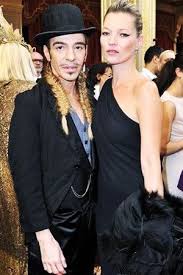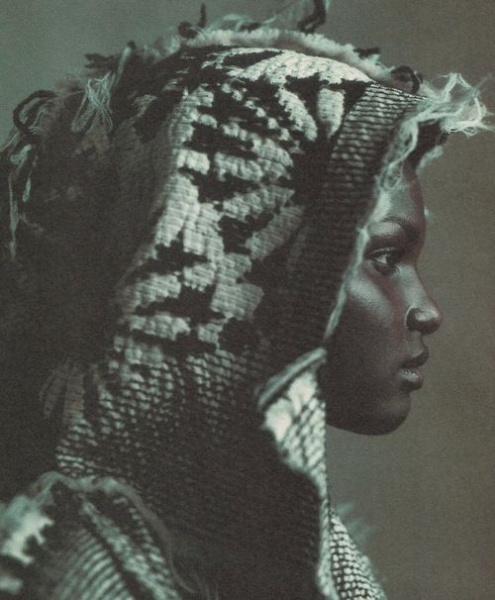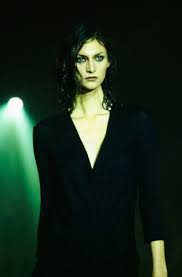BACK IN BLACK
Posted by Deirdre | Filed under Blog
The inky hue never goes out of fashion

The Amazon in a G-string gave the finger to the crowd squeezed shoulder-to-padded-shoulder into the Christian Dior ready-to-wear show in Paris this week. Then, marching menacingly up to the wall of testosterone at the end of the catwalk — otherwise known as the jeering scrum of fashion photographers — she hurled a spitball of an expletive right into the camera’s eye.
The gesture was meant to shock. But it was a mere slip of the (French) tongue in comparison to the sartorial assault that followed. Bad-boy designer John Galliano — taking his bow as a greased-down, pumped-up pugilist — delivered a one-two punch with clothes inspired by the sweaty, shifty, pugnacious world of amateur boxing. Silky boxer’s robes bobbed and weaved in gusts of air rising from angry high-heeled strides. Normally fresh-faced models sported bruises, cuts, stitches and blood manufactured by makeup artist Pat McGrath from the famously deluxe Christian Dior cosmetics line.

These kinds of antics are all too common in the increasingly derivative world of high fashion — think of Galliano’s homeless chic of two years ago. This year, it was good-bye pearls, bonjour Pulp Fashion. Like Quentin Tarantino’s movies — which have attained cult status here in France — the coming season is dark. It’s a black-washed, postmodern soup of past, present and future (read space-age) shot through with irony, fantasy and a fondness for film noir.
Dior still conjures the idea of old money, however, and there was plenty of that in the coveted front row at the Theatre National de Chaillot on Tuesday. But when the ghetto blasters came out onto the runway, hoisted by models with pierced noses, lips and brows, no one batted an eye. Everyone knows it’s all part of the carnival that is Paris fashion, and despite the hi-jinks, France’s stalwarts can still be counted on to deliver the goods.
Take Tom Ford’s much-anticipated collection for Yves Saint Laurent. Ford paid homage to YSL collections past, updating the peasant blouse in soot black fabrics that were slashed to reveal glimpses of skin. Tight-fitting velvet skirts, paired with wine-coloured leather tops with criss-crossed straps, heightened the mood of muted sexuality. Black evening dresses, the climax of the show at the rain-stained Musee Rodin on Wednesday, were cut short in the front to reveal a stockinged leg while trailing trains of silk ruffled in back. These were gorgeous clothes, meant for wearing.

At Chanel, Karl Lagerfeld likewise used the roots of the house as a starting point, but then added a good measure of kitsch to make things exciting and nouveau — as in nouveau riche. He played with a sexy, tiered mid-thigh-length flamingo skirt in leather as well as denim, and added dramatic cafe-au-lait coloured fur trims on coats. His take on the classic Chanel suit was unadorned and devoid of hardware, but it came with multiple strands of pearls. And the Chanel purse of the season? Lagerfeld swapped the signature chain for a sleek metal whip of a strap and attached it to a sleek envelope clutch.
American designer Marc Jacobs went dotty at the Louis Vuitton ready-to-wear show on Monday. Felted cavalry twill coats with maxi puff-ball mink buttons, silk dot skirts and dresses, and polka dot hose were touches of whimsy on impeccably tailored luxury fabrics. Accessories were contrasts in shape, size and texture — think large, dyed fox-fur hats with tiny monogrammed wallet purses.
No one does luxury better than Hermes, and the collection Martin Margiela presented for fall 2001 was made for today’s new breed of jet-setting aristocrats — collarless jacket and pants in grey Prince of Wales cashmere and silk, pants in night-blue lambskin, a bustier jumpsuit in black silk ottoman. The coup de grace was a short brown fur coat, worn under a trench in waterproof cotton poplin. But black was the real story at the Paris shows, bringing with it plenty of flinty attitude — hard as obsidian. Michael Kors at Celine and Marcel Marongiu fetishized black with jet leather caps — Marongiu’s had the distinct air of hard-line Gestapo hats — paired with inky trenches for a look that evoked sexy Charlotte Rampling in The Night Porter.
At Costume National, black was mystery — black-lace blouses peered coyly from behind the holes of black crocheted mohair sweaters and hid beneath fitted back jackets worn with skinny black-suede pants tucked into knee-high black studded boots. Bewitching. At Lanvin, black was a plain-speaking erotic fantasy sheathed in a butt-skimming, body-caressing mini-dress worn with long hair, bare legs and shiny black pumps.

But black’s most dramatic moment belonged to Dutch duo Viktor Horsting and Rolf Snoeren, of Viktor & Rolf, who dared to present their all-black ensembles on models in blackface. Their idea was to eliminate all distractions, create a matte palette against which the superb cut and structure of the clothes was highlighted in relief. Besides the whites of the models’ eyes, what stood out was this: hyper-extended shoulders, puffed-out and crinoline-stiffened hemlines, maxi-sized men’s ties, Edward Gorey-inspired transparent frock coats replete with high Victorian collars and boning. The lava-black chic made for arresting theatre. Theatre, fantasy, over-the-top ambition. This is what sets the Paris fashion scene apart. In contrast to Milan, which was uniformly about selling sex through highly wearable, masterfully cut, clothes in quality materials, Paris is more about cultivating a highly personal vision. To hell with commercialism, marketability and anything as bourgeois as sales. Designers in the City of Light don’t make clothes, they weave magic. Their shows are multi-media avant-garde presentations where dresses, coats, blouses and jackets are works of art.

The Japanese avant-garde was also showing its influence. Ford at YSL emulated the puckered fabric look that Issey Miyake has made his signature, while Jean-Paul Gaultier, for his own show at the Louvre on Wednesday night, took his inspiration from the deconstructed garments of Comme Des Garcons’ Rei Kawakubo.

Gaultier took men’s jackets, cut them into pieces and reassembled them in inventive ways. Sleeves hung from sheer silk camisoles by means of pins attached to harnesses. Jacket fronts emerged as skirts. Gauthier also cut the backs out of luscious fur coats, and there were red satin slips edged in black lace under distressed leather vests for a bordello cop-girl look that also showed up as a trend at Comme des Garcons.
Antwerp-based designer Bernhard Willhelm presented a show last weekend at the celebrated Moulin Rouge, where an inventive wardrobe of Roman headdresses, Sherpa jackets, batik caftans and Grecian chitons — set against a film projection of a dancing skeleton — made the models look like time travellers from an apocalyptic future.
Isabel Marant, presenting a top notch line of sexy knits in soft romantic prints at the rough-and-tumble Espace Austerlitz on Monday, also evoked death in the form of a skull embroidered on the backs of her wool jackets. Out of the eyes and mouth and nose grew trees sprouting leaves and flowers. You could read it as a sign that fashion, like nature and all of life, is self-regenerating.
Naoki Takizawa was also thinking in terms of organic forms in the collection he showed for fall at Issey Miyake. Dramatic neck pieces of branches and blossoms lent the models a look of fragile, poignant beauty and nearly upstaged the designer’s brilliantly coloured skirts and tops in hand-puckered origami-like silk and his coats that were splattered with a blurred grey-white-black pattern resembling snow melting on a dark forest floor.
Fellow Japanese designer Yohji Yamamoto married the avant-garde to sportswear in a collection that saw him forging a partnership with running-shoe manufacturer Adidas. But this being Paris, there was nary a sweat pant in sight. Instead, the distinctive Adidas stripe decorated large, puffy, asymmetrical jackets.

Olivier Theyskens is also in the process of reinventing himself. Widely considered, at age 24, the wunderkind of European new-wave fashion, he completely reversed his approach to women’s fashion for this fall and winter. Last year the Belgian designer cultivated a reputation as a gothic visionary with his black, punk, Morticia Adams clothes.
But this season, as other designers are going dark and moody, his palette is softer, his cuts sexier, his look altogether glamorous. His Hollywood-inspired collection — he cited Marilyn Monroe as muse — included a vintage white-satin bra and panties set presented as daywear with matching hose and shoes.
Theyskens told me that he never creates with anything but personal expression in mind. “I’m very intuitive,” said the designer in a backstage interview following his presentation Monday night. “I draw a lot and when I feel I have a good thing I don’t stop. But I knew it was a pleasure to work with such a rich concept, nothing minimalist. Usually I like the girlish way. But here the women are on top — both intellectually and physically. It is, how you say? More hot.”
Trend tracking
Leather accessories: Leather chokers at Lanvin and Paco Rabanne; wide leather belts over wool coats at Yves Saint Laurent; elbow-length leather gloves over suit sleeves at Costume National.
Ensemble dressing: A tiered look with pants under skirts or dresses worn with jackets. The new mixed proportions turned up at Chanel, where Lagerfeld teamed leather harem pants under skirts. Dance fever: Ballerina-flat shoes in soft leather danced down the runway at Isabel Marrant and Alexandre Herchcovitch. Tulle and crinolines popped up at several shows, most strikingly at Comme des Garcons where Rei Kawakubo used it as lining to give structure to corsets.

Trouser power: Knickers, culottes, hot pants, Bermudas, cuffed shorts, cigarette-leg jeans, harem pants, leather or suede palazzo pants — whichever way you cut it, long or short, pants are in. Funnel-necks: The high necks appeared on collared coats, jackets, blouses, dresses — close to the neck and either ruched or smooth for a dramatic look.
Capes and ponchos: They’re back. Bell-shaped, and in longhaired or sheared fur, wool and cashmere. Indian:Dress-length jumpers or vests or dresses worn with pants tied at the ankle for a look that is right out of A Passage to India. Fur hats: The Milanese had the Davy Crockett hat — complete with tail — while the Parisians worked the Dr. Zhivago version, high on the head. Everyone from Marc Jacobs at Louis Vuitton to Paco Rabanne and Christian Lacroix showed them.
Luxe legs: Coloured knee socks at Thierry Mugler, and over hose for a space-age schoolgirl effect at Junya Watanabe. Prime palette: Black rules, but white was everywhere, especially in white patent boots at Dries Van Noten and Jean-Paul Gaultier. Apple, along with almost every other shade of green, was a favourite.
(From the Deirdre Kelly Paris fashion archives)
